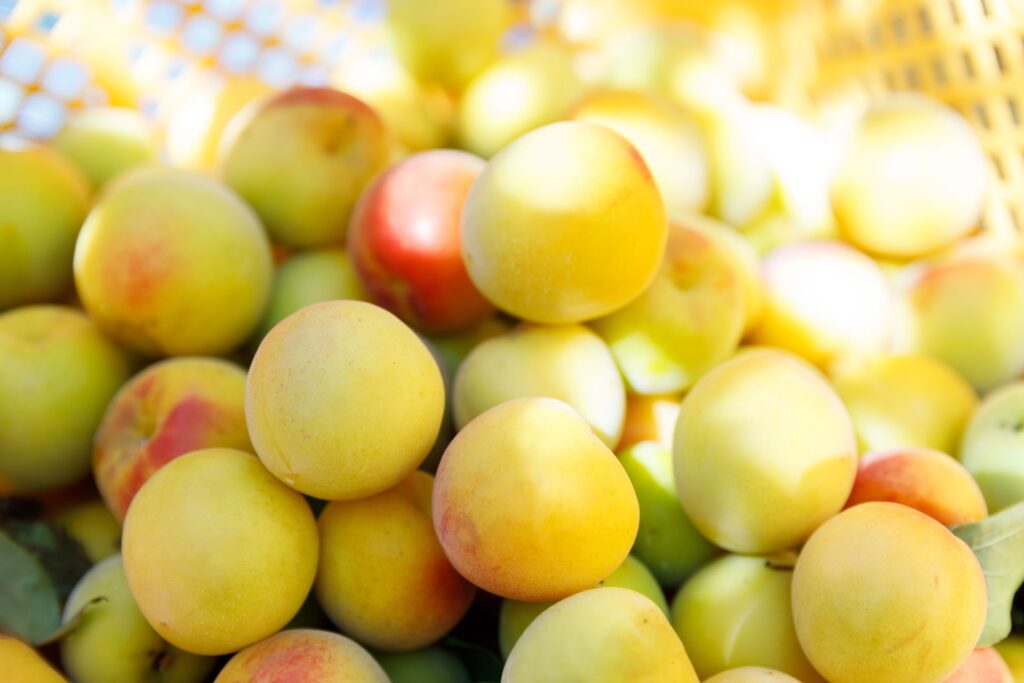From a family tradition to an emerging global trend, umeshu has travelled a long way. It is one of the most representative alcoholic drinks in Japan, with centuries of history behind it and a flavour profile suited to those who want to explore something new after sake and shochu.
What Umeshu Is
Umeshu is a liqueur made from a specific Japanese fruit called ume (somewhere between a plum and an apricot). The variety used most often is grown in the mountainous Wakayama Prefecture, a terroir that yields the finest fruit: nankou ume. The ume is picked while still unripe and macerated in a mixture of alcohol and sugar. Most of the time the sugar is cane; sometimes it is honey. The alcohol is often shochu, though sake is not uncommon.
The result tastes sweet yet lightly tart, with a relatively modest strength, usually between eight and fifteen percent ABV. Especially when young, umeshu can have a syrupy texture that gradually softens with time.
A Very Brief History
Sources suggest umeshu emerged in the same period when Japan began producing shochu, namely the late seventeenth century. One would not exist without the other, so the timing makes sense. In its early days, umeshu was made at home, each family with its own recipe—united by the same essentials: ume, sugar, and alcohol. Centuries later some things have changed—there is industrial production, for instance—yet umeshu has retained its traditional, unpretentious character.
How It Is Made

To make umeshu you need ume—of course. The fruit then macerates in alcohol and sugar for at least six months. This happens in sterilised, neutral containers (glass, for example), kept away from light in a cool place. Many experts say nine months delivers the best result. When the time is right, the liquid can be bottled. At that stage one or more ume can be slipped into the bottle—a stylistic choice by the maker that does not significantly affect flavour.
Umeshu Is Not a Wine
It is worth stressing that the process involves maceration but not fermentation. Which is why “plum wine” is a misnomer—common outside Japan, but inaccurate for this product. Without fermentation there is no wine. Umeshu is, in every respect, a liqueur.
Umeshu Without Ume?
Rising demand has brought more bottles and labels to market, yet the supply of ume has remained largely the same. The gap is explained by the fact that a liqueur made without ume—and flavoured only with artificial aromas that mimic the fruit—can still be sold as umeshu. Anyone wishing to taste a traditional expression should look for honkaku umeshu on the label, a term that certifies the presence of unripe Japanese plums in the recipe.
How Umeshu Is Served
At the beginning, umeshu was a household staple. It was easy to prepare, and families made their own. That habit has endured: umeshu remains the most common homemade liqueur in Japanese homes. It is usually made once a year, when the plums reach the ideal stage, and opened to mark a special moment—anything out of the ordinary. It is served neat at room temperature, or chilled over ice.
Umeshu is highly versatile and, like other Japanese spirits, lends itself to different serving styles. Warmth draws out aromatic depth; cold highlights refreshing acidity. Choosing one or the other (or any point in between) is simply a matter of taste.
Umeshu in Mixology
Service temperature goes hand in hand with a spirit of experimentation. Even in its homemade guise, umeshu mixes well with tonic water, soda, or fruit juices—which naturally leads to cocktails. In classic Japanese fashion it can follow the ochawari approach, combining local tea with various spirits. Green tea is often the choice here, and serving temperature follows the season: hot in winter, cold in summer.
Another route is the sour family, with a sweetener and lemon or lime juice; balance matters, so neither acidity nor sweetness overwhelms the drink. Handled with care, umeshu’s profile can converse with almost anything: with tequila in a Paloma twist, or with gin to give an oriental note to a classic Gin & Tonic via a pour of umeshu—or even by replacing the gin entirely with the Japanese liqueur.
And when the bartender pushes further, umeshu can be blended with rum, Scotch, and banana liqueur. It is one of the signatures by Christian Suzuki, who has Japanese roots and ties to San Francisco, and who describes the drink Kagano as “a love letter to my heritage and my family.”







